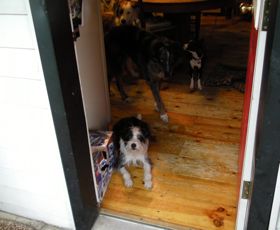
Reframing Canine Understanding : Doorways
Foodbowl Exercises and Drive
Here are a couple of scenarios:
- Handler makes dog sit at door and wait until released (or until handler has gone through) to exit the door.
- Handler makes dog sit and wait as food is put down. Dog is then released to eat food.

These are two very common tactics for dog trainers and they have benefits but they are like half open Christmas Presents – full of promise, but quite short of the awesomeness that is a fully opened present.
We call these ‘food bowl exercises’ here at Pawsitive Vybe as a short hand term for any ‘self control’ exercise that is managed by the handler and reinforced directly by the object of the dog’s drive.
A food bowl exercise is pretty good at obtaining the target behavior, sitting in front of the food bowl or sitting at the door, but does very little to alter the classically conditioned state of the dog in that situation. In the case of the dog in front of the food bowl, odds are the dog will be drooling. In the case of the door, odds are that the dog’s heart rate and blood flow will be higher than normal. These are classically conditioned responses to the target of the dog’s drive – food and outside.
Skinner Rocks but Pavlov Rules
When Skinner and Pavlov bump heads, Pavlov always wins. What we have set up in the above training scenarios is an operant behavior, usually at the behest of the handler, competing with stimuli that send our dog’s bodies into a classically conditioned tizzy. This is a Skinner vs Pavlov battle and it’s not a winner.
Even if we get the behavior we’re looking for, a good sit at the door, or a good sit in front of the food bowl, we are going to wind up with the classically conditioned state. We win the battle but lose the war. We don’t get the calm we’re looking for because all the dog can think about is what happens after this silly sit behavior is over.
What we need to do in these situations is to reframe them and change what the situation means to the dog.
Doorways Are Staging Areas
If you are currently working your door in similar fashion to the scenario above, a doorway is about going outside, or going inside, or going somewhere. Doorways are staging areas to someplace else. Absent an active handler, you might as well stick a set of drag strip lights outside and let the races begin.
When we do have an active handler, we wind up having a hard time reorienting our dogs because the only thing a door is good for is staging for the next cool place.
So when doorways are Staging Areas, the handler must be active and has to work on both sides of the door to attract the dog’s attention. That sounds like a lot of work to me.
Doorways as Destinations
What we prefer to do is to reframe the door, to change the meaning, from Staging Area to Destination. Once the doorway is a destination, then the dog is happy to hang out there. There is no driving to get outside, no classically conditioned charge to the door because going outside is not the point. The point is hanging out on either side of the door with the handler.
Once the dog believes that a doorway is a destination in and of itself, our job as handlers handling the dog at doorways becomes extremely easy. The dog will act just as they do anywhere else. Does that sound like some kind of magical dream? Welcome to Pawsitive Vybe!
Keys to Reframing the Door
Don’t make the dog sit. Don’t make the dog do anything. Capture Attention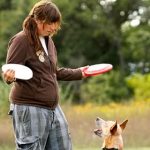 Unsolicited eye contact or Attention is a great way to hook up with a dog. If you have something the dog wants he should give eye contact in order to get access to... More and the Sit will happen. Capture the Release
Unsolicited eye contact or Attention is a great way to hook up with a dog. If you have something the dog wants he should give eye contact in order to get access to... More and the Sit will happen. Capture the Release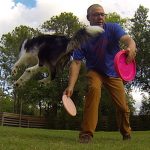 Release has many meanings in disc. Throws and throw variations can be referred to as releases. Sometimes you talk about the dog releasing something, the toy, or the environment, as in to stop... More of the Outdoors. Place lots of value on the inside of the door with cookies. Once the dog stops focusing outside and starts focusing on the handler instead, then we consider releasing the dog through the door.
Release has many meanings in disc. Throws and throw variations can be referred to as releases. Sometimes you talk about the dog releasing something, the toy, or the environment, as in to stop... More of the Outdoors. Place lots of value on the inside of the door with cookies. Once the dog stops focusing outside and starts focusing on the handler instead, then we consider releasing the dog through the door.
As we release the dog through the door we mark the moment the dog crosses the threshold and the dog will reorient to the handler in the expectation of getting a cookie (Reward for PositionIn the Play+ philosophy, "Position" is the final stage within the "Next" phase of a Cycle of Play. It acts as a pivotal link between the "Next" phase and a new "Now" phase. More). We give them a cookie and then begin to add value to the other side of the door with Attention, There It Is (similar to Look at That) and the Release of the Environment.
That’s it. If you are interested in hearing and seeing more, please leave a comment below. If you understand the lingo and situation, give it a shot.
Hat tip: to Julie Jenkins for Skinner Rocks but Pavlov Rules language… to Nate for “Some kind of Magical Dream…” $.10 royalty check is in the mail





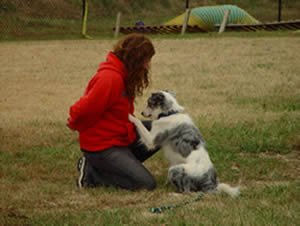

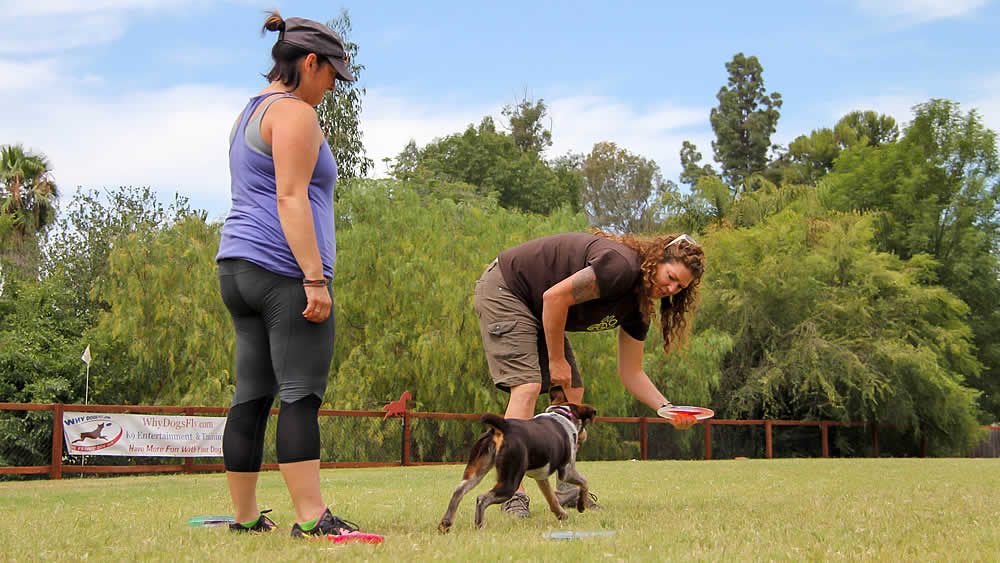
If only that had worked with Lok! Going outside is about the highest value thing there is in his WORLD. Nothing competes. I used to do the whole “sit and wait to go outside” routine and all I ended up doing was adding even MORE value to the release. It was like a flyball dog waiting for the cue to run the course! He would fall down the stairs in the entry way, smash his face into the door. Nothing mattered but getting outside. I worked for weeks on making the doorway a destination, just like you’re talking about, and got nowhere. The treats couldn’t compete with going outside and though I got a bit calmer behavior (Skinner), I never got a calmer state (Pavlov).
Maybe it would have worked had I stuck it out longer, or had I started by first desensitizing the whole process of going TO the door, or the triggers that meant we might be going out. But it wasn’t worth it to me. What has worked for us to get calmer exits is taking away the release that had added so much value to the doorway. Now instead of the rule being “you stay inside until you are told to go outside” the rule is “you go outside unless you are told to stay in.” When they are told to stay in, they know they won’t be going out, so we don’t have the quivering at the door. When they are going out, since there is no stay at the door there is no build-up of tension waiting for the release, so the exit is much more calm. This still works best if it’s just Lok going outside. If all three are at the door, the competition brings the crazy out of him again. I think Lok is an exception to the rule though. I think your strategy would work very nicely with Elo, and Jun has always walked out of doors very nicely on her own.
I had the same conversation with Abby about Joe. Then showed her how to do it the last time she was here. She was just as incredulous as you are here.
I don’t think it’s a matter of ‘what dogs it will work on’. I think it’s a matter of how it is applied. There’s a ton of nuance in those few sentences.
Also in the case of the extreme, we’d desensitize heavily in a threshold inside the house like from a bedroom to a hallway to teach the behavior, as opposed to teaching it at the apex of drive and arousal.
I’m glad that you’ve found a solution that works for you, Tania, but I’d love to take a crack at Loki on this sometime.
Peace,
Ron
So we have been diligently working on this exact thing pretty much the way you describe. No one goes out the door until I have good eye contact and then they go out one at a time as there are 7 very pumped dogs waiting to go out the door. When released as a group it is a race to the bottom as well as who can scream the loudest on the way down.
My question is about the click when released through the door. What do you do when they ignore the click and just keep on going? When my dogs are excited you can forget about reverting back to me for a cookie after a click. I know the point here is to get them to be calm on one side of the door, and that is getting better, but not near where it needs to be. As soon as I open that door and release a dog that dog goes flying mach speed out the door and to the next door.
I have thought about following the one dog all the way to the outside. Release that dog through door #1 wait on the other side of door #1 for dog to figure out why Im not coming and then c/t them for coming back until that results in them reverting back promptly, but that leaves me with a large number of super hyped dogs unattended on the other side of at least door #1.
So how do you handle more than one dog at the door? Do you teach this one dog at a time? When you click one dog how does the other dog know the click was not for them? I suppose that is a whole other article.
In the mornings here there are 3 doors to the coveted outdoors and each door is treated the same. Some days it takes us a long time to get outside!
Well you can’t teach more than one dog at a time.
Each of our 13 have to be taught individually or another threshold (doorway) must be used as the staging area for the rest of the dogs as the 1 dog gets worked. Lots of value is chucked behind the staging dogs, but that’s a juggling act I’d not want to try to teach people.
Regarding your first question:
“What do you do when your dog does not reorient to the click?”
The answer is you wait for the release of the environment and start shoveling cookies at them for eye contact, There It Is, and the Release of the environment. I’d also dismiss (go do dog stuff – on leash) out there. You can also ask them back in, marking the crossing of the threshold and repeat. Probably the step that Tania didn’t use and probably something that should have gone into the blog entry. But there are only so many words.
You need to add repetitions and change the result to go outdoors. Are the dogs on leash? If not, they probably should be. A sedate walk to go out and do their business does not lead to a highly charged classically conditioned state. Several days of that ought to slow them down. Also outside of the morning, a couple trips through door #1 and back to the living room is always a letdown. Door #1, Door #2 on lead, then go and make a sandwich kind of thing.
The idea here is to ensure that you’re addressing the classical end, which might mean leading them on and giving them an alternate ending – one that doesn’t end with a romp through the outdoors.
Peace!
Wow! I think you just blew my mind. For MONTHS we’ve been working on “reorienting” as described by Leslie McDevitt in _Control Unleashed_. Once through the doorway, getting Sam to reorient back to me before proceeding outdoors (or wherever). But it’s been slow-going. He does now at least look back/reorient once he gets through the door (especially if I’m behind him hanging on to the leash) but it’s clearly reluctant, not in the least enthusiastic. And what’s more, if he really wants to get to the yard (for whatever reason), it can take minutes before he turns around to me and once he does he often has no interest in the treat I’m offering. He just wants to go.
This has me rethinking our whole approach. Brilliant. Thank you.
Yo Jeff,
Just make sure you add lots of value to both sides of the door. And also, as mentioned in the comments here, you’ve got to alter the endgame. It always can’t end in a romp through the back yard. So several reps that leave the expectation of romping through the backyard unfulfilled per every one that does.
Perhaps you get through the door cleanly and get good reorientation as you mark the threshold then go back inside and chill out.
And if you say,”Well he did all the work, he should be able to go outside as a reward,” you missed the whole point of the piece and should reread it. That expectation of reinforcement with the environment for good door manners is exactly the problem that must be solved, in the dog’s mind and in the handler’s mind.
Peace,
Ron
Oh, and Jeff,
A ton of this is lifted from Leslie’s Control Unleashed, we’ve just added our own flavor to the mix.
“There It Is” is unsolicited Look at That with very clear criteria on what part of the behavior we’re going to mark. It is also ALWAYS unsolicited. Slight differences in flavor.
The foodbowl exercise = reinforcing with the object of the dog’s drive, I believe is a key component that we’ve added to the mix. I’ve got a theory for food gulpers that I’d like to test out that fits this.
One more thing… we’re kind of setting up a competing interest which is another way we describe this construct.
How so much can be said about something so simple just amazes me.
Dog training is simple, but not easy.
Yes, I hear you (and figured you were riffing on McDevitt); very VERY helpful. Thank you. Are you sure you don’t want to move just a couple hours to the east? Land is cheap over here in northern Oakland County, you know!
Jeff
I grew up on that side of the state, Jeff.
We owned a large chunk of Lake Property in Dryden. I remember back in the day that property in Oakland County was expensive!
The West Side is much more our pace.
It’s only a couple hours and Sunday Drop Ins are $10 or a 6 pack of Winter White – available tomorrow – YAY!
Peace.
Funny, Ron: I remember property being quite expensive up here too– just a few years ago when we bought ours! Alas!
We’ll make it over your way one of these days, I swear– with 10 bucks and maybe some home brew.
Ron, you are welcome to work with Lok anytime. It could very well be that I just suck a training him. I know this isn’t meant to be a training post, so don’t worry about clarifying, but with Lok, I could sit in the doorway with him for half an hour and do nothing and STILL not get “calm.” He’d hold his breath the entire time. He might start to relax a tiny bit, but if I moved AT ALL, back to crazy over threshhold. And this went on for two weeks! Of course, I have also never in 3 years been able to teach this dog a sit or down when there is toy out, nor have I been able to teach him loose leash walking (until he went blind and HAD to start paying attention to me). Just let me know when you want me to ship him out there! 😉
Thanks Ron! After some modifications with the living room x-pen, which now extends behind the couch and into the closet so that all the doorways are blocked off, I was able to work each dog one at a time at all the doors with the extremely lame result of a leash walk. They all thought the release to environment game was pretty cool as well.
Wow, Okay!
Had to re-read the first part (scenarios) as I thought to myself….’ummm something is wrong in the Universe’ and, ‘oh I need to talk to Ron (he messed up his wording he said “handler MAKES dog…”)…..I thought ‘opps he meant to say “dog CHOOSESs too…” but then I kept reading and I see you are making a point with the first two statements 😉 LOL
Then in my head: ‘Okay, whew, Ron has not become one of “those trainers” all is right again in the Universe, I can now regulate myself again’. And work on my own Pavlovien (sp?) response!
Ha, too funny, to me that all this internal dialoged happened from one little word (“makes”).
Anyway, on the post… love the concept, very good reminder, and totally excited about hearing more as you asked at the end of the post, great stuff, especially for me who, while embracing the concepts you described above sometimes forgets to implement them correctly, at least with my own dogs, I swear it comes sooo much easier when I am un attached to the outcome! – Yes I am sure this is another post entirely, and I am sure you have already written something up somewhere about letting go of the goal, I know we have hashed this topic out 🙂
Great stuff,
Mary
—-Sunday, Sunday, Sunday 🙂
….one more comment this is an excellent post for the primer on setting the tone, reorientation in the threshold has helped Tala more than anything while with me….if she looks for the mama when we walk into “the new place” we are off to such a better start with the environment – Ron and Apryl to credit here, you rock, in case you didn’t know it!
@Renee – Awesome!
We use an expen here for threshold work Renee. Have to do a little work up on that… It’s important to separate the dogs and get them one on one when you’re teaching stuff.
@Mary – Funny…
Glad you guys are having success, Mary.
See you Sunday!
Okay, the Pavlovian Humor post is brilliant.
And I hope you don’t mind one more question here: so attempting to put this one into practice today looks like this: we go to the back door, Sam sits as he always does in anticipation of a romp. I open the door, he stays sitting as he has learned to do. I click and treat for staying once or twice. Then I say okay and he walks out. As soon as he crosses the threshold, I mark that crossing with a click. He turns for a treat. I reward with a couple more in quick succession for eye contact. Then I say, “okay” and back inside we go.
Is that about right? I assume I’m going to gradually raise the criteria or something once we go out the door? Wait for a sit or one of his other behaviors? So that going out the door is a game in itself, not just a “portal” to a backyard romp?
Or have I got something wrong?
Jeff,
That is it, perfecto!
And try to keep the concept in mind for other situations.
Peace
Cool. Thanks, Ron; I really appreciate it. I’m thinking about the concept all the time now!